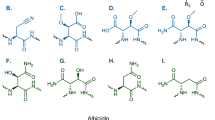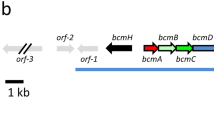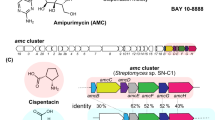Abstract
A Streptomyces pristinaespiralis strain, which produces a streptogramin antibiotic pristinamycin II (PII) as a mixture of two biologically active molecules PIIB and PIIA, was genetically engineered to produce exclusively PllA. The snaA,B genes, which encode a PIIA synthase that performs oxidation of the precursor (PIIB) to the final product (PIIA), were integrated in the chromosome of S. pristinaespiralis using an integrative derivative of the pSAM2 genetic element from Streptomyces ambofaciens. Integration was due to site-specific recombination at the attB site of S. pristinaespiralis, and no homologous recombination at the snaA,B locus was observed. The attB site of S. pristinaespiralis was sequenced and found to overlap the 3′ end of a pro-tRNA gene. The integrants were stable in industrial conditions of pristinamycin production and showed no decrease in Pll biosynthesis. Western blot analysis showed a constant production of the PIIA synthase in the overall fermentation process due to expression of the cloned snaA,B genes from the constitutive ermE* promoter. This allows the complete conversion of the PIIB form into PIIA.
This is a preview of subscription content, access via your institution
Access options
Subscribe to this journal
Receive 12 print issues and online access
$209.00 per year
only $17.42 per issue
Buy this article
- Purchase on Springer Link
- Instant access to full article PDF
Prices may be subject to local taxes which are calculated during checkout
Similar content being viewed by others
References
Preud'homme, J., Belloc, A., Charpentié, Y., and Tarridec, P. 1965. Un antibiotlque formé de deux groupes de composants à synergie d'action : la prlstinamycine. C. R. Acad. Sol. 260: 1309–1312.
Preud'homme, J., Tarridec, P., and Belloc, A. 1968. Pristinamycine : isolement, caractérlsatlon et identification des constituents. Bull. Soc. Chim. 2: 585–591.
Vazquez, D. 1975. The streptogramin family of antibiotics. Antibiotics 3: 521–534.
Cocito, C.G. 1979. Antibiotics of the virginiamycln family, inhibitors which contain synergistic components. Microbiol. Rev. 43: 145–198.
Cocito, C. and Chinali, G. 1985. Molecular mechanism of action of virginlamycin-like antibiotics (synerglmyclns) on protein synthesis in bacterial cell-free systems. J. Antimicrob. Chemother. 16 (suppl.A): 35–52.
Aumercier, M., Bouhallab, S., Capmau, M.-L., and Le Goffic, F. 1992. RP59500: a proposed mechanism for its bactericidal activity. J. Antimicrob. Chemother. 30 (suppl.A): 9–14.
Blanc, V., Lagneaux, D., Didler, P., Gil, P., Lacroix, P., and Crouzet, J. 1995. Cloning and analysis of structural genes from Streptomyces pristinaespiralis encoding enzymes involved in the conversion of pristinamycln IIB to pristi-namycin IIA (PIIA): PIIA synthase and NADH:riboflavin 5′-phosphate oxidoreductase. J. Bacteriol. 177: 5206–5214.
Thibaut, D., Ratet, N., Bisch, D., Faucher, D., Debussche, L., and Blanche, F. 1995. Purification of the two-enzyme system catalyzing the oxidation of the D-proline residue of pristinamycin IIB during the last step of pristlnamycin IIA, biosynthesis. J. Bacteriol. 177: 5199–5205.
Blanc, V., Salah-Bey, K., Folcher, M., and Thompson, C.J. 1995. Molecular characterization and transcriptional analysis of a multidrug resistance gene cloned from the pristinamycin-producing organism, Streptomyces pristinaespiralis . Mol. Microbiol. 17: 989–999.
Salah-Bey, K., Blanc, V., and Thompson, C.J. 1995. Stress-activated expression of a Streptomyces pristinaespiralis multidrug resistance gene (ptr) in various Streptomyces spp. and Escnerichia coli. Mol. Microbiol. 17: 1001–1012.
Takano, E., Gramajo, H.C., Strauch, E., Andres, N., White, J., and Bibb, M.J. 1992. Transcriptional regulation of the redD transcriptional activator gene accounts for growth-phase-dependent production of the antibiotic undecylprodiglosin in Streptomyces coelicolor A3(2). Mol. Microbiol. 6: 2797–2804.
Gramajo, H.C., Takano, E., and Bibb, M.J. 1993. Stationary phase production of the antibiotic actinorhodin in Streptomyces coelicolor A3(2) is transcriptionally regulated. Mol. Microbiol. 7: 837–845.
Hopwood, D., Malpartida, F., Kieser, H.M., Ikeda, H., Duncan, J., Fuji, I. et. al. 1985. Production of “hybrid” antibiotics by genetic engineering. Nature 314: 642–644.
Katz, L. and Donadio, S. 1993. Polyketide synthesis: prospects for hybrid antibiotics. Annu. Rev. Microbiol. 47: 875–912.
McDaniel, R., Khosla, E., Hopwood, D.A., and Khosla, C. 1995. Rational design of aromatic polyketide natural products by recombinant assembly of enzymatic subunits. Nature 375: 549–554.
Alvarez, M.A., Fu, H., Khosla, C., Hopwood, D.A., and Bailey, J.E. 1996. Engineered biosynthesis of novel polyketides: properties of the whiE aromatase/cyclase. Nature Biotechnology 14: 335–338.
Thomas, D.I., Cove, J.H., Baumberg, S., Jones, C.A., and Rudd, B.A.M. 1991. Plasmid effects on secondary metabolite production by a streptomycete synthesizing an anthelmintic macrollde. J. Gen. Microbiol. 137: 2331–2337.
Pernodet, J.-L., Simonet, J.-M., and Guérineau, M. 1984. Plasmids in different strains of Streptomyces ambofaciens: free and Integrated form of plasmid pSAM2. Mol. Gen. Genet. 198: 35–41.
Boccard, F., Pernodet, J.-L., Friedmann, A., and Guérineau, M. 1988. Site-specific integration of plasmid pSAM2 in Streptomyces lividans and Streptomyces ambofaciens . Mol. Gen. Genet. 212: 432–439.
Boccard, F., Smokvina, T., Pernodet, J.-L., Friedmann, A., and Guérineau, M. 1989. The integrated conjugative plasmid pSAM2 of Streptomyces ambofaciens is related to temperate bacteriophage. EMBO J. 8: 973–980.
Boccard, F., Smokvina, T., Pernodet, J.-L., Friedmann, A., and Guéineau, M. 1989. Structural analysis of loci involved in pSAM2 site-specific integration in Streptomyces. Plasmid 21: 59–70.
Smokvina, T., Boccard, F., Pernodet, J.-L., Friedmann, A., and Guérineau, M. 1991. Functional analysis of the Streptomyces ambofaciens element pSAM2. Plasmid 25: 40–52.
Hagège, J., Boccard, F., Smokvina, T., Pernodet, J.-L., Friedmann, A., and Guérineau, M. 1994. Identification of a gene encoding the replication initiator protein of the Streptomyces integrating element, pSAM2. Plasmid 31: 166–183.
Hagège, J., Pernodet, J.-L., Friedmann, A., and Guérineau, M. 1993. Mode and origin of replication of pSAM2, a conjugative integrating element of Streptomyces ambofaciens . Mol. Microbiol. 10: 799–812.
Hagège, J., Pernodet, J.-L., Sezonov, G., Gerbaud, C., Friedmann, A., and Guérineau, M. 1993. Transfer functions of the conjugative integrating element pSAM2 from Streptomyces ambofaciens: characterization of a kil-kor system associated with transfer. J. Bacteriol. 175: 5529–5538.
Sezonov, G., Hagége, J., Pernodet, J.-L., Friedmann, A., and Guérineau, M. 1995. Characterization of pra, a gene for replication control in pSAM2, the integrating element of Streptomyces ambofaciens . Mol. Microbiol. 17: 533–544.
Smokvina, T., Mazodier, P., Boccard, F., Thompson, C.J., and Guérineau, M. 1990. Construction of a series of pSAM2-based integrative vectors for use in actinomycetes. Gene 94: 53–59.
Soussy, C.J., Acar, J.F., Cluzel, R., Courvalln, P., Duval, J., Fleurette, J. et al. 1992.A collaborative study of the in-vitro sensitivity to RP 59500 of bacteria Isolated in seven hospitals in France. J. Antimicrob. Chemother. 30 (suppl.A): 53–58.
Barrière, J.C., Bouanchaud, D.H., Paris, J.M., Rolin, O., Harris, N.V., and Smith, C. 1992. Antimicrobial activity against Staphylococcus aureus of semlsynthetic injectable streptogramins: RP 59500 and related compounds. J. Antimicrob. Chemother. 30 (suppl.A): 1–8.
Smokvina, T. 1990. Contribution à la caractérisatlon de pSAM2, un élément génétlque mobile de Streptomyces . Ph.D. thesis. Université de Paris-Sud, Orsay.
Bibb, M.J., Janssen, G.R., and Ward, J.M. 1986. Cloning and analysis of the promoter region of the erythromycin-resistance gene (ermE) of Streptomyces erythraeus . Gene 41:E357E368.
Bibb, M.J., White, J., Ward, J.M., and Janssen, G.R. 1994. The mRNA for the 23S rRNA methylase encoded by the ermE gene of Saccharopolyspora erythraea is translated in the absence of a conventional ribosome-blnding site. Mol. Microbiol. 14: 533–545.
Mazodier, P., Thompson, C., and Boccard, F. 1990. The chromosomal integration site of the Streptomyces element pSAM2 overlaps a putative tRNA gene conserved among actinomycetes. Mol. Gen. Genet. 222: 431–434.
Hopwood, D.A., Bibb, M.J., Chater, K.F., Kieser, T., Bruton, C.J., Kieser, H.M. et. al. 1985. Genetic manipulation of Streptomyces. A laboratory manual. The John Innes Foundation, Norwich, England.
Vallins, W.J.S., and Baumberg, S. 1985. Cloning of a DNA fragment from Streptomyces griseus which directs streptomycin phosphotransferase activity. J. Gen. Microbiol. 131: 1657–1669.
Cox, K.L., and Seno, E.T. 1990. Maintenance of cloned biosynthetic genes in Streptomyces fradiae on freely-replicating and integrative plasmid vectors. Abstracts of the 14th UCLA Symposia, in J. Cell. Blochem. (suppl. 14A): Abstract CC016.
Sezonov, G., Hagège, J., Pernodet, J.-L., and Guérineau, M. 1995. Biology of a Streptomyces integrating element, pSAM2. In: Proceeding of the Ninth International Symposium on the Biology of the Actinomycetes. Biotechnologia (Russia) 7-8: 80–84.
Kuhstoss, S., Richardson, M.A., and Rao, R.N. 1989. Site-specific integration in Streptomyces ambofaciens: localization of integration functions In S. ambofaciens plasmid pSAM2. J. Bacteriol. 171: 16–23.
Sambrook, J., Fritsch, E.F., and Maniatis, T. 1989. Molecular cloning: a laboratory manual. Cold Spring Harbor Laboratory Press. Cold Spring Harbor, NY.
Thompson, C.J., Ward, J.M., and Hopwood, D.A. 1980. DNA cloning in Streptomyces: resistance genes from antibiotic-producing species. Nature 286: 525–527.
Laemmli, U.K. 1970. Cleavage of structural proteins during the assembly of the head of bacteriophage T4. Nature 227: 680–685.
Alegre, M.-T., Cournoyer, B., Mesas, J.-M., Guérineau, M., Normand, P., and Pernodet, J.-L. 1994. Cloning of Frankia species putative tRNAPro genes and their efficacy for pSAM2 site-specific integration in Streptomyces lividans . Appl. Environ. Microbiol. 60: 4279–4283.
Kay, R., and McPherson, J. 1987. Hybrid pUC vectors for addition of new restriction enzyme sites to the ends of DNA fragments. Nucleic Acids Res. 15: 2778.
Author information
Authors and Affiliations
Rights and permissions
About this article
Cite this article
Sezonov, G., Blanc, V., Bamas-Jacques, N. et al. Complete conversion of antibiotic precursor to pristinamycin IIA by overexpression of Streptomyces pristinaespiralis biosynthetic genes. Nat Biotechnol 15, 349–353 (1997). https://doi.org/10.1038/nbt0497-349
Received:
Accepted:
Issue Date:
DOI: https://doi.org/10.1038/nbt0497-349
This article is cited by
-
Medium optimization of Streptomyces sp. 17944 for tirandamycin B production and isolation and structural elucidation of tirandamycins H, I and J
The Journal of Antibiotics (2014)
-
Enhanced production of validamycin A in Streptomyces hygroscopicus 5008 by engineering validamycin biosynthetic gene cluster
Applied Microbiology and Biotechnology (2014)
-
Probing the Molecular Mechanisms for Pristinamycin Yield Enhancement in Streptomyces pristinaespiralis
Current Microbiology (2012)
-
Conjugal Transferring of Resistance Gene ptr for Improvement of Pristinamycin-Producing Streptomyces pristinaespiralis
Applied Biochemistry and Biotechnology (2010)
-
Finetuning pristinamycin synthesis in streptomycetes
Nature Biotechnology (1997)



